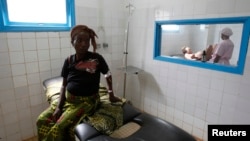Hundreds of pregnant women and girls are dying needlessly in South Africa due to failures in the country’s health system, according to Amnesty International report. Amnesty says countries across Africa are failing to meet targets for reducing maternal mortality, despite progress elsewhere in the world.
Antenatal care is free in South Africa’s public health system. But that does not mean pregnant women and girls are getting the care they need, according to the report, which was based on research in two eastern provinces.
Amnesty International’s Louise Carmody spoke to VOA from South Africa.
She says many women and girls do not visit clinics until the later stages of their pregnancy because they fear being tested for HIV and the stigma associated with testing positive. She said some women and girls say health care workers openly discuss HIV test results with others.
“We saw issues around different colored files for pregnant women who were living with HIV and different lines, or queues, for medication for people living with HIV, and those were representative of concerns that women and girls had highlighted themselves,”says Carmody.
There were more than 1,500 recorded maternal deaths in South Africa in 2011 and almost as many in 2012. Amnesty says more than a third of the deaths were linked to HIV, and 60 percent were avoidable.
Carmody says transport remains a major problem, roads in some areas Amnesty surveyed are in such poor condition they cannot be used when it rains. “When women and girls found themselves in labor and the baby was about to come they would tell us that the ambulance shortage was so profound that they were told to make their own way to the hospital. So they would have to pay between $40 and $100 to get to the hospital when the baby was coming,” she explains.
London School of Oriental and African Studies expert on social aspects of health in Africa Michael Jennings says high maternal mortality rates in South Africa are related to the same problems in other countries in the region.
“It shares many of the same barriers, even if it is a much richer country. Issues around cultural preferences for traditional birth attendants; critically, the issue of gender power dynamics, where women have less power over their own bodies and less power over where they go for facilities; access to transport, even if transport is free, if you have to pay to get to that facility that makes it extremely difficult for many women,” he states.
Jennings says women’s mortality rates are directly linked to their social, economic and political status. He says it is far too easy to neglect women's health needs if their voices are not heard in policy and planning forums.
Jennings also says international donors often insist on conditions for the use of aid, and this has made it more difficult for developing countries to improve health services.
“So for example, developing countries often find that they are limited in the amount they are able to spend on health care services or on, for example, public sector wages. And while that may seem understandable from a donor perspective, if you can not invest in wages, if you can not hire new staff, if you can not pay to retain the staff that you have, then you can not build a national health system,” he notes.
In the year 2000 a Millennium Development Goal was set to reduce maternal deaths by three quarters between 1990 and 2015. In eastern Asia, northern Africa and southern Asia, maternal mortality has declined by around two-thirds since 1990.
According to the United Nations, the goal for South Africa is a maternal mortality ratio of 38 per 100,000 births. The current ratio is nearly 300 per 100,000 births.






